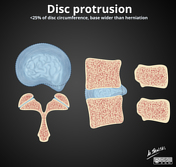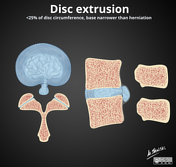Disc herniation
Disclosures
- updated 3 May 2023:
- Philips Australia, Paid speaker at Philips Spectral CT events (ongoing)
Updates to Article Attributes
Body
was changed:
Disc herniation refers refers to the displacement of intervertebral disc material beyond the normal confines of the disc but involving less than 25% of the circumference (to distinguish it from a disc bulge). A herniation may contain nucleus pulposus, vertebral endplate cartilage, apophyseal bone/osteophyte and annulus fibrosus.
Disc herniations can be divided into groups in a variety of ways. Commonly they are divided into protrusion vs extrusion:
-
protrusion
- base wider than herniation
- confined to disc level
- outer annular fibres intact
-
extrusion
- base (a.k.a. neck) narrower than herniation 'dome'
- may extend above or below endplates or adjacent vertebrae
- complete annular tear with passage of nuclear material beyond disc annulus
- disc material can then migrate away from annulus or become sequestered
Herniations can further be classified as:
- contained
- with intact outer fibres of annulus fibrosus and posterior longitudinal ligament, or
- with intact posterior longitudinal ligament alone
- not contained
- tear of outer fibres of annulus fibrosus and posterior longitudinal ligament
See also
-<p><strong>Disc herniation</strong> refers to the displacement of <a href="/articles/intervertebral-disc">intervertebral disc</a> material beyond the normal confines of the disc but involving less than 25% of the circumference (to distinguish it from a <a href="/articles/disc-bulge">disc bulge</a>). A herniation may contain <a href="/articles/nucleus-pulposus">nucleus pulposus</a>, <a href="/articles/vertebral-endplate">vertebral endplate</a> cartilage, apophyseal bone/<a href="/articles/osteophyte-2">osteophyte</a> and <a href="/articles/annulus-fibrosus">annulus fibrosus</a>. </p><p>Disc herniations can be divided into groups in a variety of ways. Commonly they are divided into protrusion vs extrusion: </p><ul>- +<p><strong>Disc herniation</strong> refers to the displacement of <a href="/articles/intervertebral-disc">intervertebral disc</a> material beyond the normal confines of the disc but involving less than 25% of the circumference (to distinguish it from a <a href="/articles/disc-bulge">disc bulge</a>). A herniation may contain <a href="/articles/nucleus-pulposus">nucleus pulposus</a>, <a href="/articles/vertebral-endplate">vertebral endplate</a> cartilage, apophyseal bone/<a href="/articles/osteophyte-2">osteophyte</a> and <a href="/articles/annulus-fibrosus">annulus fibrosus</a>. </p><p>Disc herniations can be divided into groups in a variety of ways. Commonly they are divided into protrusion vs extrusion: </p><ul>
-<li>with intact posterior longitudinal ligament alone </li>- +<li>with intact posterior longitudinal ligament alone </li>
Images Changes:
Image 3 Diagram ( update )

Caption
was changed:
Figure 3: disc protrusion
Image 4 Diagram ( update )

Caption
was changed:
Figure 4: disc extrusion
Image 7 Diagram ( create )

Caption
was added:
Figure 7: location
Position
was set to
7.







 Unable to process the form. Check for errors and try again.
Unable to process the form. Check for errors and try again.